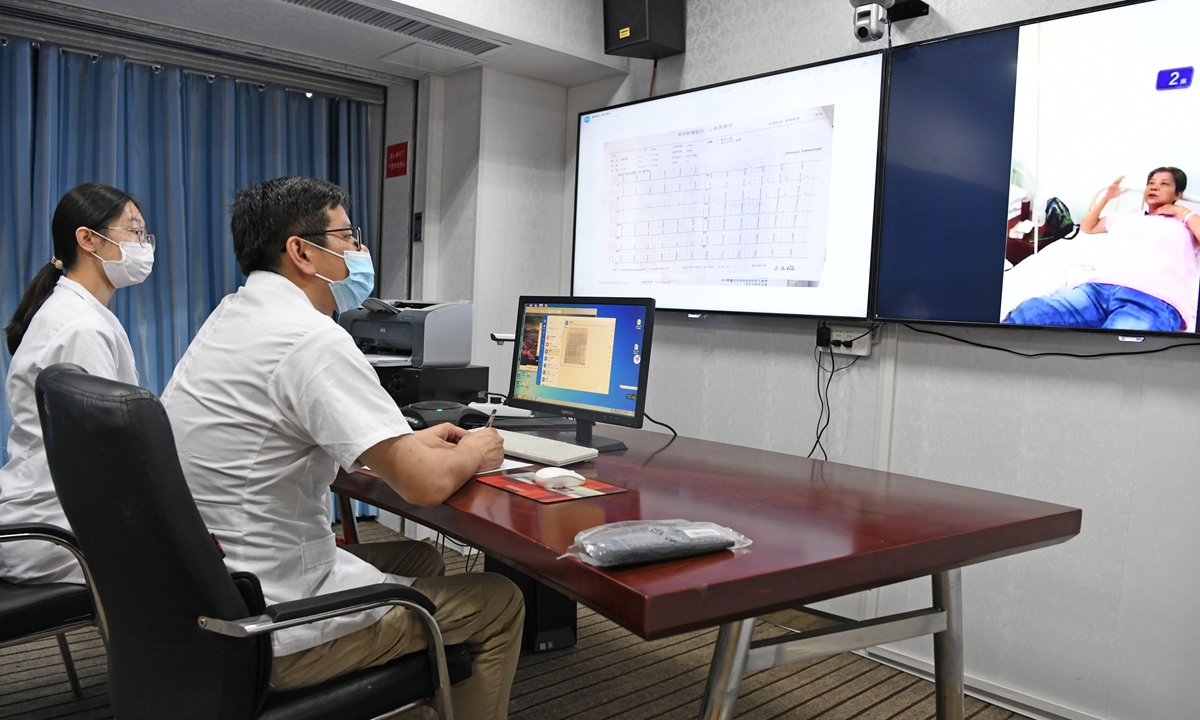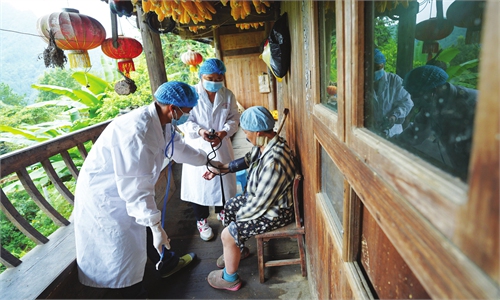IN-DEPTH / IN-DEPTH
Improved public health facilities at grassroots level reflect CPC’s pledge for health rights

Doctors from Huainan First People's Hospital in East China's Anhui Province conduct an online consultation with patients at a local community health service center on August 19, 2020. Photo: VCG
Public health facilities are the most basic guarantee for the human rights of life and health, and the Communist Party of China (CPC) has continually given top priority to health care at the grassroots level, which is reflected in the achievements of a series of medical reforms over the last decade and China's determination to protect the safety of its people in the fight against COVID-19, Su Wei, a professor at the Party School of the CPC Chongqing Municipal Committee, told the Global Times.
In order to build a higher quality primary health service system, over the last decade, China has strengthened the management and training of rural doctors, aiming to build a high-caliber team of doctors serving the grassroots, providing safe, effective, convenient, and affordable basic medical services to the most in-need groups, Su underlined.
China has made use of the advantages of its economy to rebuild the medical public resources network, which has been accelerated significantly since the 18th National Congress of the CPC. Medical reforms in the last 10 years have expanded the scope of medical insurance, reduced drug costs, weeded out corruption in medical procurement, equalized medical resources in different regions, and prevented more people from falling back into poverty due to illness, Su introduced.
Basic medical and health services have become more equitable and accessible, narrowing the gaps in resource allocation, service capability, and health conditions between urban and rural areas and among different regions and groups, Su noted.
"Many of the medical standards and equipment in urban and rural hospitals are constantly being equalized. Doctors in township health centers in some developed areas can perform surgery, which was unimaginable 10 years ago. This shows that the medical public service goal has been steadily implemented," said Su.
Moreover, the Chinese government has greatly innovated medical and health undertakings in the minority regions, tackling the problem of doctor and medication shortages that have existed for a long time there.
Southwest China's Xizang Autonomous Region, for example, has improved itinerant medical services at the grassroots level for people living at high altitudes or in remote areas, said local authorities.
Grassroots-level health workers have been further bolstered. By the end of 2020, there were more than 4.3 million grassroots health workers, including more than 1 million rural doctors in China. The level of education, quality, and professionalism of these grassroots personnel have also been greatly improved, the National Health Commission suggested in February.
Additionally, health science and technology innovation were significantly enhanced, and life expectancy continued to increase over the last decade, Su suggested.
By 2035, China's health care system will adapt to the basically achieved socialist modernization. Chinese people's average life expectancy will soon be over 80 with a gradually rising average healthy life expectancy.
Impressed by what he called China's "surprising" achievements in medical care, Dr. Bernard P. Kean, the World Health Organization (WTO)'s representative in China, said that he could hardly believe it was a developing country by looking only at such statistics as life expectancy, infant mortality, and causes of death.
The General Office of the State Council issued a plan in February to improve policies on national health, and to push forward the Healthy China initiative to meet people's growing need for well-being during the 14th Five-Year Plan period (2021-2025).
The plan urged an accelerated setting up of institutions and systems that put people's health first, stressing the taking of health into consideration in all policies, and underlining the importance of developing healthy lifestyles and work ethos, while highlighting disease prevention with a focus on major diseases, risk factors, and attention to vulnerable groups.
The Party's determination to defend and protect people's right to life and health is also evident in the fight against COVID-19, which can only be achieved under the socialist system as led by the CPC, said Su.
China's medical and health care system is different from the industrialized medical structure of the West. China's medical reform is closely linked to the grassroots governance system. China's institutional advantages, efficient deployment capabilities, and human resource advantages can all be reflected in the process of comprehensive modernization at a medical level, Su stressed.

